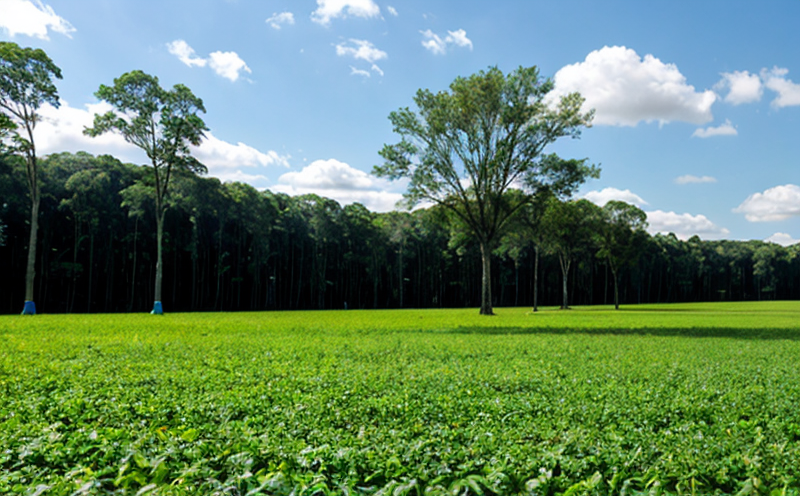Environmental Impact Assessment of Consumer Goods
The environmental impact assessment (EIA) of consumer goods is a critical process that evaluates the ecological footprint and sustainability aspects of products throughout their lifecycle. This service helps quality managers, compliance officers, R&D engineers, and procurement teams ensure that the products they develop or source do not contribute disproportionately to environmental degradation. By focusing on the early stages of product design, this assessment can significantly influence the development of more sustainable consumer goods.
The EIA process involves several key steps: identification of potential impacts, prediction and evaluation of these impacts, and mitigation strategies. Each step is crucial in understanding how a particular consumer good interacts with its environment. For instance, the lifecycle analysis (LCA) component examines raw material extraction, manufacturing processes, packaging, use phases, and disposal or recycling options.
Consumer products encompass a broad spectrum from textiles to electronics, each presenting unique challenges related to environmental impact. Textiles, for example, often involve the use of water-intensive dyes and chemicals that can pollute water bodies. Electronics, on the other hand, are notorious for containing hazardous materials like lead and mercury which pose significant disposal issues.
Our approach ensures a comprehensive understanding of these challenges by leveraging advanced testing methodologies aligned with international standards such as ISO 14040 and ISO 14044. These standards provide a robust framework for conducting LCA, ensuring that the assessments are both credible and internationally recognized.
The EIA also considers social impacts alongside environmental ones, recognizing that sustainable products should not only protect ecosystems but also contribute positively to communities. This holistic view is particularly important in sectors like textiles where fair labor practices can significantly enhance consumer trust.
Our team of experts works closely with clients to tailor the assessment process according to specific product categories and market requirements. By integrating stakeholder feedback into our assessments, we ensure that the resulting insights are actionable and aligned with business goals.
The results of an EIA provide invaluable data for decision-making processes within organizations. For instance, they can guide the development of more sustainable materials or design changes aimed at reducing waste generation during production. Additionally, these findings can inform marketing strategies by highlighting eco-friendly features of products, thereby appealing to environmentally conscious consumers.
Our commitment to excellence in environmental impact assessment is reflected not only in our methodology but also in our continuous pursuit of innovation within the field. We stay abreast of emerging trends and technologies that promise greater efficiency and reduced environmental harm. This proactive stance ensures that we remain at the forefront of providing cutting-edge solutions for assessing consumer goods.
By investing in an EIA, businesses not only comply with regulatory requirements but also enhance their brand reputation through responsible practices. The insights gained from such assessments can lead to long-term cost savings and improved competitiveness by fostering innovation in sustainable product design.
Scope and Methodology
The scope of our environmental impact assessment service is broad, covering all stages of the consumer goods lifecycle—from raw material acquisition through manufacturing processes, distribution channels, usage patterns, to end-of-life considerations. Our methodology adheres strictly to recognized international standards such as ISO 14040 and ISO 14044, which guide us in conducting lifecycle assessments accurately.
- Identification of potential environmental impacts
- Prediction of these impacts based on available data
- Evaluation against set criteria to determine significance levels
- Mitigation strategy development to address identified issues
The assessment begins with a thorough review of existing documentation provided by clients, including product specifications and manufacturing processes. This initial phase helps establish a baseline understanding of the current environmental performance of the products being evaluated.
Following this groundwork, we proceed with field measurements where necessary to gather accurate data on emissions, resource consumption rates, energy efficiency levels, etc. These实地环境影响评估服务提供的是针对消费产品的全面生命周期评价,从原材料采购到制造过程、分销渠道、使用阶段直至最终处置或回收。我们的方法严格遵循国际标准如ISO 14040和ISO 14044,以确保评估的准确性和可靠性。
- 识别潜在的环境影响
- 基于现有数据预测这些影响
- 根据设定的标准对这些影响进行评价以确定其重要性等级
- 制定缓解策略来解决已识别的问题
评估的第一阶段是从客户提供的现有文档开始,包括产品规格和制造过程。这初步阶段有助于建立一个关于被评估的产品当前环境表现的基准理解。
在这一基础之上,我们进行必要的现场测量以获取准确的数据,如排放量、资源消耗率、能效水平等。这些信息对于全面了解产品的环境影响至关重要。





